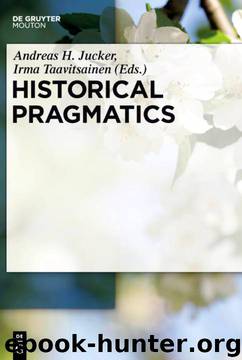Historical Pragmatics (Handbooks of Pragmatics) by Unknown

Author:Unknown
Language: eng
Format: epub
Published: 2013-04-20T14:14:00+00:00
4. Nominal and phrasal address
Studies on terms of address that apply pragmatic frameworks to old documents also date back to the beginning of historical pragmatics; in this case, topics of interest are the sociopragmatic values of terms and their shifts over time, as well as structural and semantic elements. Like other sensitive items, terms of address are often subject to reduction and/or grammaticalisation into pronouns (Simon 2003), e.g. madam < ma dame `my lady', Romanian dumneata < domnia to `your lordship', or Dutch U< Uwe Edelheid `your grace' (Braun 1988: 60-61), and the above mentioned Spanish Usted. They also undergo bleaching and generalisation or weakening of meaning at a rather fast pace, when not pejoration (e.g. lady from respectful to generic, sirrah from generic to demeaning, dame from respectful to demeaning/ironic; Salmon 1967: 63). Terms of address tend to be nouns or noun phrases of different lengths; their inventory changes in size and typology over time within a language, besides varying widely across languages (Braun 1988; Jucker and Taavitsainen 2003: 2). They are pragmatically important, especially in languages that do not express sociopragmatic values through pronouns, for instance ancient Greek (Dickey 1997) or modern English. Such terms often have a separate tone unit, and relate both to social elements (as in the case of titles, professional terms and kinship terms) and to pragmatic elements, as in the case of terms of endearment or insults. This tends to occur particularly in their function as vocatives (i.e. address forms used in invocation or in opening an utterance, to select the addressees and attract their attention, therefore with mainly phatic functions), a category that is considered a subset of address, and that involves, in many languages, the use of a specific case marking or other structural properties (Hill 2007).
Research on English has traced the introduction, changes and obsolescence of many terms of address; for instance, goodman was widely employed for yeomen in the Middle Ages, then came to indicate people of inferior status in Elizabethan times (Salmon 1967: 53), when master and sir became widespread for addressing men of higher status, and were later generalised (Williams 1992: 84-85). A considerable amount of research concerns sir, originally a highly deferential title connected with sire, and used in this way in Chaucer (Mazzon 2000: 149). Although in the Renaissance it was still mainly used to address gentlemen (Salmon 1967: 52), in Shakespeare sir is employed also in ways that are not deferential (Brown and Gilman 1989: 189), and it can even be challenging, downgrading or offensive in post-Elizabethan English (Williams 1992: 86; Brownlees 2005: 181-182), depending on the context and on the interlocutor.9 The issue of which title to use to address a stranger without causing offence is often commented on and mentioned explicitly, also in literary texts, since addressing seems to have been a vital aspect of social skills at that time (Nevala 2003: 162). The addressing of strangers is particularly sensitive because, through the first address formula, one "places" the interlocutor with respect
Download
This site does not store any files on its server. We only index and link to content provided by other sites. Please contact the content providers to delete copyright contents if any and email us, we'll remove relevant links or contents immediately.
The Goal (Off-Campus #4) by Elle Kennedy(13472)
Kathy Andrews Collection by Kathy Andrews(11709)
Diary of a Player by Brad Paisley(7460)
What Does This Button Do? by Bruce Dickinson(6123)
Assassin’s Fate by Robin Hobb(6102)
Big Little Lies by Liane Moriarty(5679)
Altered Sensations by David Pantalony(5030)
Pale Blue Dot by Carl Sagan(4886)
Sticky Fingers by Joe Hagan(4086)
The Death of the Heart by Elizabeth Bowen(3531)
The Heroin Diaries by Nikki Sixx(3480)
Beneath These Shadows by Meghan March(3249)
Confessions of a Video Vixen by Karrine Steffans(3230)
How Music Works by David Byrne(3157)
The Help by Kathryn Stockett(3067)
Jam by Jam (epub)(3004)
Harry Potter 4 - Harry Potter and The Goblet of Fire by J.K.Rowling(2974)
Strange Fascination: David Bowie: The Definitive Story by David Buckley(2782)
Petty: The Biography by Warren Zanes(2682)
